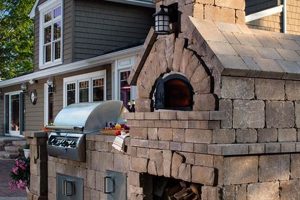Crafting a patriotic emblem from wood offers an avenue for creative expression and personal connection to national symbolism. This activity typically involves utilizing lumber, paint, and basic tools to construct a representation of the United States flag. The project allows for individual interpretation regarding dimensions, wood type, painting techniques, and distressing effects.
Producing a handmade symbol of national identity fosters a sense of accomplishment and civic pride. It can serve as a tangible expression of patriotism, a decorative element within a home, or a personalized gift for others. Historically, the creation of flags has been a method of expressing allegiance and demonstrating unity, making this craft a continuation of that tradition in a modern context. The resulting artwork can then serve as a lasting symbol of freedom and remembrance.
Subsequent sections will explore specific construction methods, material selection considerations, and various design approaches for building a wood-based national banner. Further, finishing techniques, display options, and potential safety concerns related to the project will also be addressed.
Construction Advisories
Adhering to fundamental principles during the creation process enhances the aesthetic appeal and longevity of the finished product. These guidelines are intended to promote high-quality outcomes and mitigate potential complications.
Tip 1: Material Selection: Prioritize the utilization of kiln-dried lumber to minimize warping and cracking following completion. Softwoods, such as pine, are more readily available and easier to work with; however, hardwoods provide superior durability.
Tip 2: Accurate Measurements: Ensure precise measurements when cutting the wood components. Discrepancies in size can lead to misalignment and visual imperfections. A meticulous approach at this stage reduces the need for corrective actions later.
Tip 3: Secure Fastening: Employ appropriate fastening methods, such as screws or nails, in conjunction with wood glue. This combination provides a robust bond and prevents separation of the wood pieces over time. Countersinking screws and filling the holes produces a smooth appearance.
Tip 4: Priming and Sealing: Apply a primer before painting to improve paint adhesion and prevent absorption into the wood grain. Following painting, a clear sealant will protect the finish from environmental factors and enhance its resistance to wear.
Tip 5: Consistent Paint Application: Use multiple thin coats of paint rather than a single thick coat. This technique prevents drips and ensures even color distribution. Allow each coat to dry completely before applying the next.
Tip 6: Star Placement Accuracy: Exercise care when arranging the stars to adhere to the official proportions. Utilizing a stencil or template will help achieve uniform spacing and alignment.
Tip 7: Edge Treatment: Smooth the edges of the wooden structure to prevent splinters. This can be achieved through sanding or routing, enhancing both the aesthetic appeal and the safety of the finished article.
Proper adherence to these techniques enhances the final piece’s structural integrity and aesthetic quality. Thoughtful attention to detail during each phase of the build process is paramount.
The following section will address various decorative styles and methods of achieving a weathered or rustic appearance on the patriotic piece.
1. Wood Selection
Wood selection represents a foundational element in the successful creation of a patriotic wooden art piece. The type of wood employed directly influences the final product’s appearance, structural integrity, and longevity. Choosing an inappropriate wood can lead to warping, cracking, or premature deterioration, thereby compromising the symbolic representation and its intended lifespan. For instance, using untreated pine in a high-humidity environment may result in significant warping over time, distorting the flag’s shape and causing paint to crack.
The density and grain of the wood also affect the ease of construction and the quality of the painted finish. Softer woods, like pine or cedar, are easier to cut and nail but may be more susceptible to dents and scratches. Harder woods, such as oak or maple, offer greater durability but require more specialized tools and techniques for shaping and fastening. The grain pattern can either enhance or detract from the flag’s design; a consistent, tight grain typically provides a smoother surface for painting the stripes and star field, while a highly figured grain may introduce visual distractions. For Example: oak is durable, but can be hard to work with, whereas redwood may be soft and pliable, but may not be very durable to outside forces.
Therefore, careful consideration of wood characteristics is critical for any project. Factors such as intended location (indoor vs. outdoor), desired aesthetic, and the craftsman’s skill level should inform the selection process. Investing in suitable lumber not only ensures a visually appealing final product, but also protects the integrity of the symbolism. An understanding of different wood properties mitigates the risk of structural failure and ensures that the finished piece serves as a lasting emblem.
2. Dimensional Accuracy
Dimensional accuracy constitutes a critical element in the creation of a wooden rendition of the United States flag. Inaccurate proportions compromise the symbolic representation, resulting in a distorted and aesthetically displeasing outcome. The United States flag adheres to specific dimensional standards codified in federal law, dictating the relative sizes of the canton (the blue field with stars), the stripes, and the overall flag dimensions. Deviations from these standards can diminish the visual impact and convey a lack of attention to detail. For example, if the stripes are not of equal width, or if the canton is disproportionately sized, the resulting flag will appear unbalanced and unprofessional. Failing to adhere to these standards can take away from the overall aesthetics.
The practical implications of dimensional inaccuracies extend beyond mere aesthetics. Correct dimensions are essential for the proper placement of the stars within the canton. The stars must be uniformly spaced and aligned according to the flag’s official design. Errors in the canton’s dimensions or the placement of the stars detract from the flag’s symbolic meaning and can even be interpreted as disrespectful. For example, if the stars are clustered too closely together or are misaligned, the flag loses its intended clarity and visual harmony. The amount of precision needs to be exact, as even a small imperfection can create a ripple effect.
In conclusion, dimensional accuracy is not merely a technical requirement but an integral component of respecting the flag’s design and symbolism. Proper adherence to established proportions ensures a visually appealing and symbolically accurate final product. While slight variations may occur in handmade items, striving for dimensional precision is paramount to creating a wooden flag that honors the national emblem and reflects craftsmanship.
3. Color Fidelity
Color fidelity represents a crucial aspect in crafting a wooden United States flag. Accurate color reproduction directly affects the recognizability and symbolic significance of the finished product. Deviations from the established color codes for “Old Glory Red” and “Old Glory Blue,” as defined by the Institute for Color Research, can diminish the flag’s visual impact and potentially alter its intended meaning. For instance, using a maroon or crimson shade instead of the prescribed red can create a somber or muted effect, while substituting a lighter, cerulean hue for the official blue can result in a less authoritative and more informal appearance. The utilization of incorrect shades compromises the flag’s symbolic power.
The practical implications of color fidelity extend to the perceived quality and professionalism of the handmade flag. Accurate color matching requires careful selection of paints or stains and meticulous application techniques. Inconsistent paint mixing or uneven application can lead to variations in color across the stripes or within the star field, resulting in a visually disjointed and amateurish appearance. Furthermore, exposure to sunlight or other environmental factors can cause certain colors to fade or shift over time, underscoring the importance of using high-quality, fade-resistant paints and sealants. For example, employing a low-grade acrylic paint that is not UV-resistant may cause the red stripes to fade to a pale pink within a year, rendering the flag visually inaccurate and diminishing its symbolic value.
Achieving color fidelity in a DIY wooden flag project presents challenges, particularly for those with limited experience in color mixing or paint application. However, the availability of pre-mixed paints in the official flag colors and the use of color charts as reference guides can significantly improve accuracy. The adoption of proper painting techniques, such as applying multiple thin coats and allowing sufficient drying time, further enhances the consistency and vibrancy of the colors. Maintaining color fidelity, therefore, requires both attention to detail and a commitment to using appropriate materials and methods, ensuring the final product represents a respectful and accurate rendition of the United States flag.
4. Star Arrangement
The arrangement of stars within the canton of a wooden representation of the American flag directly impacts the visual authenticity and symbolic integrity of the piece. Incorrect placement, spacing, or orientation of the stars compromises the flag’s established design, detracting from its representational accuracy. The official design mandates a specific pattern of five-pointed stars, arranged in horizontal rows and vertical columns, precisely positioned within a blue field. Deviations from this arrangement, whether intentional or unintentional, undermine the flag’s established symbolism and can be perceived as a sign of disrespect or negligence. An example of incorrect star arrangement would be uneven spacing, which can diminish the visual harmony and suggest a lack of attention to detail. A poorly executed star field detracts from the overall symbolic importance.
The accurate placement of stars on a wooden rendition requires meticulous planning and execution. Crafting a star field often involves using stencils, templates, or pre-cut star appliques to ensure consistent shape and spacing. The size and proportions of the stars must also be carefully considered in relation to the overall dimensions of the canton. A common issue encountered is the tendency for stars to appear crowded or unevenly distributed, particularly when working with smaller-sized flags. Addressing this challenge often involves precise measurements, careful marking, and the application of steady hand techniques. In this manner, a well-executed star field enhances the overall aesthetic appeal and symbolic value of the wooden emblem.
Effective star arrangement necessitates a combination of technical skill and attentiveness to detail. Adhering to established guidelines for star placement is paramount to creating a visually accurate and symbolically respectful wooden American flag. While artistic interpretations may be permissible, maintaining the fundamental arrangement of stars is crucial for preserving the flag’s integrity. The star field is the most visually noticeable component of the flag and warrants the most precision to ensure accuracy and honor the overall design.
5. Finishing Technique
The application of a finishing technique represents a critical stage in the construction of a wood-based national banner. This process directly influences the item’s aesthetic appeal, protection from environmental factors, and overall longevity. The proper implementation of a finishing regimen elevates the piece from a mere collection of materials to a lasting artistic symbol.
- Sealing
Sealing the painted surface protects against moisture, UV radiation, and physical abrasion. Application of a clear coat or varnish forms a protective barrier, preventing fading, cracking, and damage to the underlying paint layers. For instance, an exterior spar varnish is often used on items designed for outdoor display, providing enhanced resistance to weather conditions. Without an adequate sealant, the paint is vulnerable to environmental degradation, leading to a premature decline in the item’s appearance and structural integrity.
- Distressing
Distressing techniques impart a weathered or aged aesthetic to the flag. This process involves intentionally creating imperfections, such as sanding edges, applying antiquing glazes, or simulating wear patterns. A flag with a distressed finish may evoke a sense of history or rustic charm, adding to its visual appeal. Distressing should be applied judiciously to enhance the overall design rather than detracting from its representational integrity.
- Texturing
Texturing involves altering the surface of the wood to create a tactile or visual effect. This can be achieved through various methods, such as wire brushing, carving, or applying textured paints or coatings. A textured finish adds depth and dimension to the flag, enhancing its visual interest and providing a unique tactile experience. Texturing techniques should complement the overall design and not obscure the painted details.
- Polishing
Polishing creates a smooth, lustrous surface, enhancing the vibrancy of the colors and providing a professional finish. This technique is typically applied after sealing the painted surfaces, using fine-grit abrasives and polishing compounds. A polished finish adds a touch of elegance to the wooden emblem, making it suitable for display in more formal settings. The polishing process must be executed carefully to avoid damaging the underlying paint layers.
In summary, finishing techniques are indispensable to achieving a durable and visually striking wood creation. Whether aiming for a pristine, polished appearance or a rustic, weathered aesthetic, the selection and application of appropriate finishing methods are critical to protecting the item from the elements and enhancing its overall symbolic impact. The careful consideration of finishing options allows one to tailor the final product to individual preferences, ensuring it remains a cherished display piece for years to come.
6. Distressing Effects
Incorporating distressing effects into a handmade wooden United States flag introduces an element of historical context and visual texture. These techniques intentionally create an aged or weathered appearance, adding depth and character to the piece. The strategic application of distressing techniques transforms a newly constructed item into a symbol that evokes a sense of history and resilience.
- Sanding and Abrasion
Sanding and abrasion involve selectively removing paint or wood to simulate wear and tear. This technique can be applied to edges, corners, and surfaces to reveal underlying layers or create a rough texture. For example, sanding the edges of the stripes exposes the wood beneath, giving the impression of years of use and weathering. In the context of a flag, this method represents the trials and tribulations the nation has endured. This can include war, natural disasters, or other periods of national crisis.
- Staining and Glazing
Staining and glazing techniques use tinted coatings to enhance the wood grain and add depth to the distressed appearance. Applying a dark stain followed by wiping it away leaves residue in the wood’s pores and crevices, accentuating its texture and creating an aged effect. Glazes, similar to stains, add subtle color variations, mimicking the effects of dirt and grime accumulating over time. With the use of staining and glazing, flags can symbolize historical significance and are often regarded as more memorable.
- Dry Brushing
Dry brushing involves applying a small amount of paint with a dry brush to create a streaked or faded appearance. This technique is particularly effective for highlighting raised surfaces and adding subtle variations in color. For instance, dry brushing white paint over the blue field of stars can create a hazy or weathered effect, suggesting the passage of time or the influence of environmental factors. The dry brushing technique can also symbolize the trials and tribulations of a nation’s past.
- Crackling Mediums
Crackling mediums are paints or varnishes that, when applied, create a network of fine cracks on the surface. This effect mimics the natural aging process of paint and adds a distinct visual texture. Applying a crackling medium over the painted stripes or the star field adds authenticity, creating a subtle yet noticeable effect that enhances the overall distressed appearance. An aged appearance suggests a nation’s long history and the importance of remembering our past. This symbolizes the flag as being a symbol of freedom for many years.
In summation, the use of distressing effects on the handmade wood emblem introduces layers of visual interest and symbolic meaning. Each technique contributes to a story of age and resilience, transforming a simple wooden construction into a potent and evocative national symbol. When displaying a flag with distressing effects, viewers will have a greater appreciation for the flag as a symbol of the nation’s history. With the correct application, viewers will understand the importance of remembering the past and celebrating freedom.
7. Hanging Hardware
The selection and installation of appropriate hanging hardware are integral to the safe and secure display of a self-constructed wooden United States flag. The weight and dimensions of the flag necessitate hardware capable of supporting the load without risk of failure. Insufficient or improperly installed hardware presents a risk of the flag falling, potentially causing damage to the flag itself, the surrounding environment, or, in extreme cases, injury. For example, a large wooden flag constructed from dense hardwood may weigh upwards of 20 pounds, requiring heavy-duty D-rings and appropriately sized screws anchored securely into wall studs. Neglecting to account for the flag’s weight and using lightweight picture hangers could result in the hardware failing, leading to the flag falling and causing damage. Hardware ensures that the product is secure and won’t fall.
The choice of hanging hardware extends beyond mere load-bearing capacity. The visual appearance of the hardware should complement the flag’s design and not detract from its aesthetic appeal. Recessed D-rings or sawtooth hangers provide a clean, unobtrusive look, while decorative chains or ropes can add a rustic or nautical flair, depending on the desired style. Moreover, the installation method must be carefully considered to ensure the hardware is securely attached to the flag without compromising its structural integrity. Using screws that are too short or failing to pre-drill pilot holes can weaken the wood, increasing the risk of the hardware pulling out over time. Choosing between chains, or mounts is a matter of preference that needs to be reviewed prior to the construction phase.
In summary, the connection between hanging hardware and a self-made wooden patriotic standard is one of practical necessity and aesthetic integration. Selecting and installing appropriate hardware ensures the flag can be displayed safely and securely while complementing its overall design. Addressing this seemingly minor detail is crucial for preserving the flag’s integrity and preventing potential accidents or damage, allowing it to serve as a lasting symbol. The wrong hardware could result in a flag that is not aesthetically pleasing or, even worse, one that is dangerous to have on display.
Frequently Asked Questions
This section addresses common inquiries regarding the construction and maintenance of handcrafted wooden representations of the United States flag.
Question 1: What is the optimal type of wood for constructing this piece?
Kiln-dried softwood, such as pine, offers a balance of workability and affordability. Hardwoods, like oak or maple, provide superior durability but require more specialized tools. Cedar is a favorable choice for outdoor flags due to its natural resistance to decay.
Question 2: How does one ensure accurate proportions when building a flag from wood?
Adherence to official flag dimensions, as outlined in federal regulations, is paramount. Using a scaled template or drafting the design on paper prior to cutting wood components aids in maintaining dimensional accuracy.
Question 3: What type of paint is recommended for replicating the flag’s colors?
Exterior-grade acrylic latex paint is advisable for its durability and resistance to fading. Utilizing paint swatches that accurately match “Old Glory Red” and “Old Glory Blue” ensures color fidelity.
Question 4: What is the most effective method for arranging the stars within the canton?
Employing a stencil or template facilitates the accurate placement and uniform spacing of the stars. Pre-cut star appliques offer an alternative for achieving consistent star shapes.
Question 5: How can the finished product be protected from the elements?
Application of a clear coat sealant, specifically formulated for exterior use, shields the painted surfaces from moisture, UV radiation, and physical abrasion. Regular reapplication of the sealant is recommended to maintain protection.
Question 6: What safety precautions should be observed during the construction process?
Eye protection is essential when cutting, sanding, or painting. Working in a well-ventilated area minimizes exposure to paint fumes. Secure workpieces with clamps to prevent movement during cutting and fastening operations.
Careful consideration of these aspects contributes to the creation of a high-quality, enduring patriotic emblem.
The subsequent section will provide guidance on proper display methods and ethical considerations related to displaying this national symbol.
Conclusion
The preceding sections have provided a comprehensive examination of constructing a “diy wooden american flag.” The considerations of material selection, dimensional accuracy, color fidelity, star arrangement, finishing techniques, distressing effects, and hanging hardware represent critical elements in achieving a visually accurate and structurally sound representation of the national symbol. Proper attention to these details elevates the project from a mere craft activity to a meaningful expression of national pride.
The creation of a flag from wood embodies a tangible connection to the principles and history the emblem represents. It is incumbent upon individuals undertaking this endeavor to approach it with respect and diligence. While personal interpretations are permissible, maintaining the core elements of the design ensures the finished piece appropriately honors the values and heritage of the United States. May these artistic endeavors serve as reminders of our shared identity.







